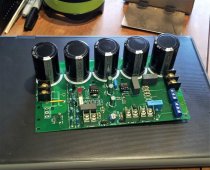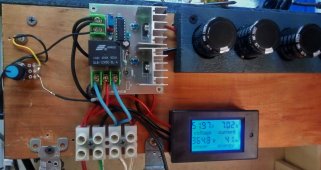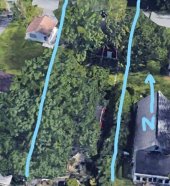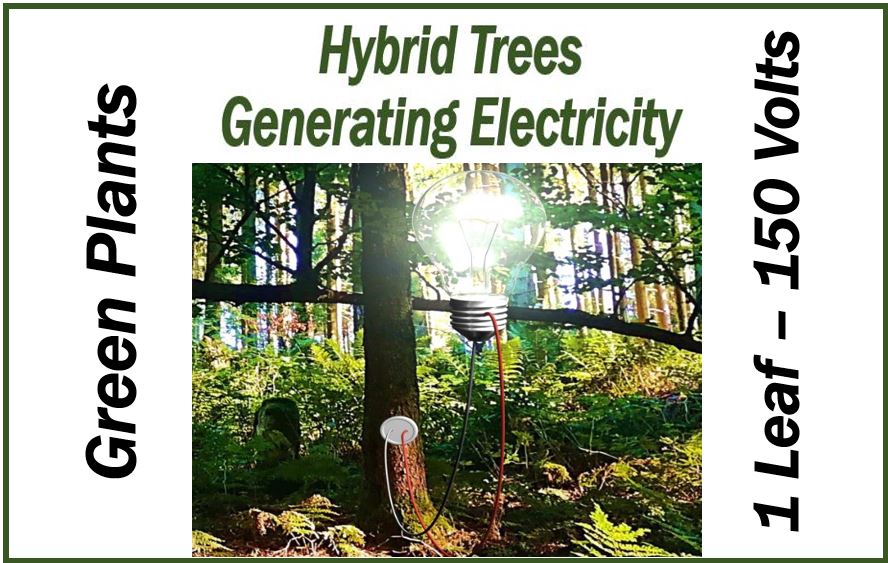Sounds ok in theory, but expensive to manufacture, install and maintain. Plus typically a much smaller area is needed for direct solar water heating than PV for any given size installation.I don’t know why the market hasn’t offered a dual PV-thermal panel. Can preheat the water before the storage tank, and will cool the panels adding to their efficiency. Reduces the footprint and install cost over separate PV and thermal panels.
You are using an out of date browser. It may not display this or other websites correctly.
You should upgrade or use an alternative browser.
You should upgrade or use an alternative browser.
PV->hot water
- Thread starter Aphers
- Start date
McKravitts
Solar Enthusiast
- Joined
- Sep 8, 2022
- Messages
- 534
I have a hot water solar panel with an 80 gallon storage tank.
The hot water from this tank feeds into a 40 gallon propane heated tank.
During the summer months:
The thermostat controlling the 40 gallon tank rarely turns on.
If the 80 gallon tanks temperature rises to 8 degrees above th 40 gallon tanks temp, a differential controller turns on a circulator pump bewteen the two tanks. This gives me a total of 120 gallons of solar hot water storage.
In the winter months:
The solar 80 gallon tank just acts as a preheater for the 40 gallon tank.
The system requires a good differential controller, a circulator pump and some check valves and access to propane but it works great and has been in service for over a decade now.
In theory the 40 gallon tank could be heated by solar/battery, but as mentioned above that method is very inefficient if you use a direct electric heating element. A small solar/electric powered heat pump could more than double the efficiency but I'm not aware of any such devices on the market.
The hot water from this tank feeds into a 40 gallon propane heated tank.
During the summer months:
The thermostat controlling the 40 gallon tank rarely turns on.
If the 80 gallon tanks temperature rises to 8 degrees above th 40 gallon tanks temp, a differential controller turns on a circulator pump bewteen the two tanks. This gives me a total of 120 gallons of solar hot water storage.
In the winter months:
The solar 80 gallon tank just acts as a preheater for the 40 gallon tank.
The system requires a good differential controller, a circulator pump and some check valves and access to propane but it works great and has been in service for over a decade now.
In theory the 40 gallon tank could be heated by solar/battery, but as mentioned above that method is very inefficient if you use a direct electric heating element. A small solar/electric powered heat pump could more than double the efficiency but I'm not aware of any such devices on the market.
Last edited:
That's the website I've been using, but I don't see anywhere that it tells me peak output?You can put the figures in here and see what your panels can produce with that configuration. Then factor in inverter efficiency.
JRC Photovoltaic Geographical Information System (PVGIS) - European Commission
Photovoltaic Geographical Information System (PVGIS)re.jrc.ec.europa.eu
efficientPV
Solar Addict
- Joined
- Sep 24, 2019
- Messages
- 1,368
I have that exact unit and it has been working well for a few years. It is even mounted in my hot attic (125F+) in the summers and so far it's on it 3rd or 4th Summer and still working.
Regarding building things, I love to build things but do not understand electrical/electronics as well as you do. I have read (most if not all) of what you have written about PV diversion to hot water but still can't quite figure it all out but if I had a good design plan to build from I certainly could and would build it.
I was trying to set someone up in business building these modules and bought enough parts to build 100. Thought he could probably sell three a month and make a little extra money. There was no interest and he lost interest. Initially did build a number of these complete boards for evaluation and sold them dirt cheap to get some feedback. Only one person ever got back to me. One I had to send out FEDEX and I know three years later it has never been installed. Not getting involved with solar people again. There have been many around the word that have built from scratch. They are a more motivated and have provided some information. This is one of the boards.

They are not overly complicated, and China should be selling these for $60. A Spanish technical paper on PV water heating said about the same thing, 60 euros. This picture is of a $10 inverter board with a couple minor modifications. Certainly adding a couple capacitors would be in that price range.

These are the two tanks in series for domestic hot water. Primary is a BOSCH ES series and the other is a cheap tank from China. Note that this tank says 41C. It normally is at 60C, but I am doing dishes at the time. The heater control switches to the dishwasher when it is on. I checked the primary tank and it is off indicating that it is up to temperature. There is also a 40 gallon tank in the garage just for laundry, all cycles use hot water. So three controllers each having its own priority of which heats first. What is different is my hot water tanks are not in the house. I started enclosing the big one because the insulation is not that good. That will be important in the fall When the shed cools. Tanks typically need 75W just to maintain temperature. The nice thing is the tanks use standard mechanical heater controls/elements and could be plugged into a generator if necessary.

Last is a google earth picture of my property. See any solar panels? Lots of shade. If people can't heat water with PV, don't blame me.

GSXR1000
Solar Enthusiast
- Joined
- Nov 20, 2020
- Messages
- 865
in US? like more infoMine had no problem with me doing my own install with an inspection. Passed inspection and has been running for over a year.
Ampster
Renewable Energy Hobbyist
If you don't already have an electric water heater consider a Heat Pump Water Heater. They are more expensive but only use about 25% of the energy of a resistance element in traditional electric water heaters. The ones I know from Rheem and Ruud (same company) have timers so you would not even need a diverter. Since they only draw 500 Watts I have mine timed to run from 10AM to 4PM to avoid peak rates and charge from solar. If you don't want to do Net Metering you can buy a GT inverter which has an option for no export. You just have to put the Current transformer close to the meter so that the HPWH uses the power before it gets to the meter.At it's most basic, can I install some panels, a grid tie inverter, and a diverter, to use solar to heat a tank of water?
Are there any other components required?
Ampster
Renewable Energy Hobbyist
This was asked in another thread and the consensus was thermal adds complexity and cost. Solar panels are cheap and to compensate for loss of efficiency due to high temperatures on the roof, you can just overpanel with a DC to AC rato of 1.25 to 1 or greater for the same inverter cost. The most efficient way to heat water is to transfer heat from the enviroment with a Heat Pump Water Heater. Moving heat is five times more efficient than a traditional resistive element in a typical electric water heater.I don’t know why the market hasn’t offered a dual PV-thermal panel.
But that would presumably mean buying a new tank, with a coil in it? Mine only has immersion elements.If you don't already have an electric water heater consider a Heat Pump Water Heater. They are more expensive but only use about 25% of the energy of a resistance element in traditional electric water heaters. The ones I know from Rheem and Ruud (same company) have timers so you would not even need a diverter. Since they only draw 500 Watts I have mine timed to run from 10AM to 4PM to avoid peak rates and charge from solar. If you don't want to do Net Metering you can buy a GT inverter which has an option for no export. You just have to put the Current transformer close to the meter so that the HPWH uses the power before it gets to the meter.
Last is a google earth picture of my property. See any solar panels? Lots of shade. If people can't heat water with PV, don't blame me.
View attachment 156280
No way... you must have you genetically modified your trees to photosynthesise electricity.

Green plants generate electricity - 150 volts per leaf
Italian scientists say that green plants are capable of generating electricity, which we could then use. They made a hybrid tree.
 marketbusinessnews.com
marketbusinessnews.com
jasonojordan
New Member
in US? like more info
Yes in the US. Northern Minnesota.
efficientPV
Solar Addict
- Joined
- Sep 24, 2019
- Messages
- 1,368
Interesting article. In grade school I took an aptitude test (way back when they thought you could test for everything) and it said I should be a scientist, engineer or farmer. Back in the early 60's when I was 13, I was growing plants with ultrasonics. That did make me a winner at the state science fair. I don't know why that never took off.No way... you must have you genetically modified your trees to photosynthesise electricity.

Green plants generate electricity - 150 volts per leaf
Italian scientists say that green plants are capable of generating electricity, which we could then use. They made a hybrid tree.marketbusinessnews.com
True but what do you do in winter? Wouldnt a solar thermal hot water heater on the roof freeze? Then you’d have to drain it come winter and do solar electric anyways. Our wood fired hot water.
Generally it's done with a heat exchanger, the liquid used has antifreeze in so doesn't freeze except in the harshest of winters
hwy17
Anti-Solar Enthusiast
Fafco made a dual PV and pool solar thermal panel.
I never read into it but I am sure it died or virtually died because their PV tech couldn't keep up. As soon as you get the product design done the PV world will have moved on.
I never read into it but I am sure it died or virtually died because their PV tech couldn't keep up. As soon as you get the product design done the PV world will have moved on.
Appears you can even order what @efficientPV linked to on the eBay UK site in the USA as well: https://www.ebay.com/itm/263523458861?hash=item3d5b38df2d:g:0wQAAOSwbQhgd3IZ
Solutions I know about:
A- Direct DC to the heating element
Two MPPTs can't be connected to the same panel at the same time, so this prevents panels from being used with an inverter.
If the electronics fail shorted the heater will be powered continuously until the mechanical thermostat shuts it off. Water heater thermostats are not rated for DC, so it will arc and start a fire. If the mechanical thermostat is removed, then nothing will stop the heating, so the safety valve will open and there will be a flood of boiling water.
Rating: meh
B- Panels to grid tied inverter, and AC powered heating element
If you have net metering then this is the simplest, just use a relay.
If you don't have net metering, then most smart electricity meters do the energy metering per-period so if you want to reduce your bill you can't use on/off control. You have to modulate the heater power according to excess solar.
B1- You have too much solar
That's my case, I put 12kW on the roof because I'm going to use it to run air conditioning on the whole house. In this case I get enough power to not need to modulate the heater, so I just use a relay controlled by an orange pi that talks to the meter.
B2- You don't have too much solar
So now you need to modulate the heater power to avoid drawing from the grid. That needs a way to measure excess solar power, either DIY or a modbus smartmeter, and some brains, your choice of arduino/Pi/etc.
B2a- You don't care about power factor and EMI
Just use a phase cut triac dimmer, it's cheap and effective.
B2b- You do
Then you need a pure sine wave dimmer, and most solutions are going to be more expensive than the extra solar panels to get into case B1 above, so it's only for purists and nerd engineers.
There are only two solutions, either a pure sine wave dimmer like Fronius Ohmpilot ($$$$) or DIY (hard), or use a three phase 3x800W 400VAC heating element on 230VAC, that reduces power. It has three heating elements so that provides power steps. Add a bunch of relays and/or triacs and you can make a relatively simple variable power heater.
-
A- Direct DC to the heating element
Two MPPTs can't be connected to the same panel at the same time, so this prevents panels from being used with an inverter.
If the electronics fail shorted the heater will be powered continuously until the mechanical thermostat shuts it off. Water heater thermostats are not rated for DC, so it will arc and start a fire. If the mechanical thermostat is removed, then nothing will stop the heating, so the safety valve will open and there will be a flood of boiling water.
Rating: meh
B- Panels to grid tied inverter, and AC powered heating element
If you have net metering then this is the simplest, just use a relay.
If you don't have net metering, then most smart electricity meters do the energy metering per-period so if you want to reduce your bill you can't use on/off control. You have to modulate the heater power according to excess solar.
B1- You have too much solar
That's my case, I put 12kW on the roof because I'm going to use it to run air conditioning on the whole house. In this case I get enough power to not need to modulate the heater, so I just use a relay controlled by an orange pi that talks to the meter.
B2- You don't have too much solar
So now you need to modulate the heater power to avoid drawing from the grid. That needs a way to measure excess solar power, either DIY or a modbus smartmeter, and some brains, your choice of arduino/Pi/etc.
B2a- You don't care about power factor and EMI
Just use a phase cut triac dimmer, it's cheap and effective.
B2b- You do
Then you need a pure sine wave dimmer, and most solutions are going to be more expensive than the extra solar panels to get into case B1 above, so it's only for purists and nerd engineers.
There are only two solutions, either a pure sine wave dimmer like Fronius Ohmpilot ($$$$) or DIY (hard), or use a three phase 3x800W 400VAC heating element on 230VAC, that reduces power. It has three heating elements so that provides power steps. Add a bunch of relays and/or triacs and you can make a relatively simple variable power heater.
-
Looks like a solar diverter is a fairly simple way to achieve what I need. I'm considering this model:

 coolenergyshop.com
coolenergyshop.com

Cool Energy diverTech - Solar Power Diverter - CE-DT3000W
Cool Energy diverTech - Solar Power Diverter - CE-DT3000W Features: The Cool Energy diverTech Solar Energy Diverter is designed to harvest energy that would normally be exported to the grid. It monitors the whole house electricity supply and when export is detected it starts to divert...
 coolenergyshop.com
coolenergyshop.com
Hi efficient,but nobody here builds anything.
I want to build can you help? Do you have a noob write up for direct panel to DC water elements/tanks/heaters?
I didn't see a sticky at the top of the water heater section for basics etc. I watched a Missouri wind and solar video and I have a few questions
I have 26 panels (36v 250w ) stacked in my back yard doing nothing so I thought why not heat some water. 2 years ago I already built an off grid 24 panels system running a 8kw controller to 28kwh, feeding a 6000w inverter. The issue is heating water on cloudy days vs my 28kwh battery vs everything else, well pump So I thought why not take the batteries out of the equation so everything else doesn't die after a few cloudy days. So I plan to wire up to 4 panels directly to element/s. I have in floor heating as a backup and and water to store energy in a water heater that then circulates in a closed loop into the floor. I can add multiple water heaters if needed even 6 gallon ones with DC elements and have the water stored in the floor. I also have a few stock tanks for animals.
Some thoughts:
1.) Probably asked a millions times so I hope you have a write up. Where is the best place to buy reputable DC thermostats that don't cost a fortune and or how to tell they aren't just AC. Are there any good sellers on Aliexpress?
There aren't many on Amazon with a lot of reviews even 100+
This looked good - DERNORD https://a.co/d/2pISrGg
2.) I guess one issue I see is possibly longevity of the element vs voltage (24v vs 48v elements running off 36v panels)
3.) I was thinking about making a 6" PVC tube that would go towards the middle of the stock tank with a glued bottom cap bulk heads, and a loose top cap for element changing and thermostats, also put it in the middle of the water depth with maybe 4 elements facing all directions in the water to heat from the inside out. Leaks would be the issue that could electrocute an animal, I assume there is a DC GFCI breaker I could use tho. The reason for the PVC is I'd like to make this portable vs putting elements in all the tanks as the animals move from pasture to pasture every few months. Just a thought...
4.) Where do I get the thermostats same as elements? Again, I assume there are a lot of fraudsters out there. I like it to heat up to 105 or 110 degrees max prior to -4 degree Fahrenheit nights.
5.) I don't think I have seen a bent element before, whats that all about, vs double of single regular elements?
6.) What about bulkheads. Looks like they are 1 Inch NPSM
They mention banjo TF100 in the video which is just 1" NPT. Brass or stainless might be better tho.
https://a.co/d/10HmEgD
7.) If I heat from above like mounted to a 2x6 board over the tank so I can move tank to tank every month, what happens if the element is not fully submerged?
I guess thats about it, thanks for your time and help and tips!
Best wishes,
Stew
Video I watched, but I assume prices are cheaper than $36 per element and $15 for a basic temp thermostat.

Ps sorry about the grammar its been a long day
Last edited:
pollenface
Solar Addict
I recently installed a 250L heat pump hot water system. I'm impressed by how unnoticeable it's power consumption is. It still has about 35w standby draw which is roughly 0.5kwh from the batteries through the night.
I didn't go with direct solar heating because it rains too much in winter, however i can still produce sufficient power on rainy days from PV.
I didn't go with direct solar heating because it rains too much in winter, however i can still produce sufficient power on rainy days from PV.
And for completeness, there is also...B2- You don't have too much solar
So now you need to modulate the heater power to avoid drawing from the grid. That needs a way to measure excess solar power, either DIY or a modbus smartmeter, and some brains, your choice of arduino/Pi/etc.
B2a- You don't care about power factor and EMI
Just use a phase cut triac dimmer, it's cheap and effective.
B2b- You do
Then you need a pure sine wave dimmer...
B2c - You don't have incandescent bulbs or care about flicker
In that case, you can build a burst-mode diverter - see link in my post #11 on this thread.
UK type triac diverter on AliExpress, also available in UK rebranded at double the price.
For off grid this type of dimmer control can use data of SOC etc to feed a water heater.
More details here
and projects on Github.
For off grid this type of dimmer control can use data of SOC etc to feed a water heater.
More details here
and projects on Github.
Similar threads
- Replies
- 3
- Views
- 276
- Replies
- 28
- Views
- 936
- Replies
- 6
- Views
- 527



